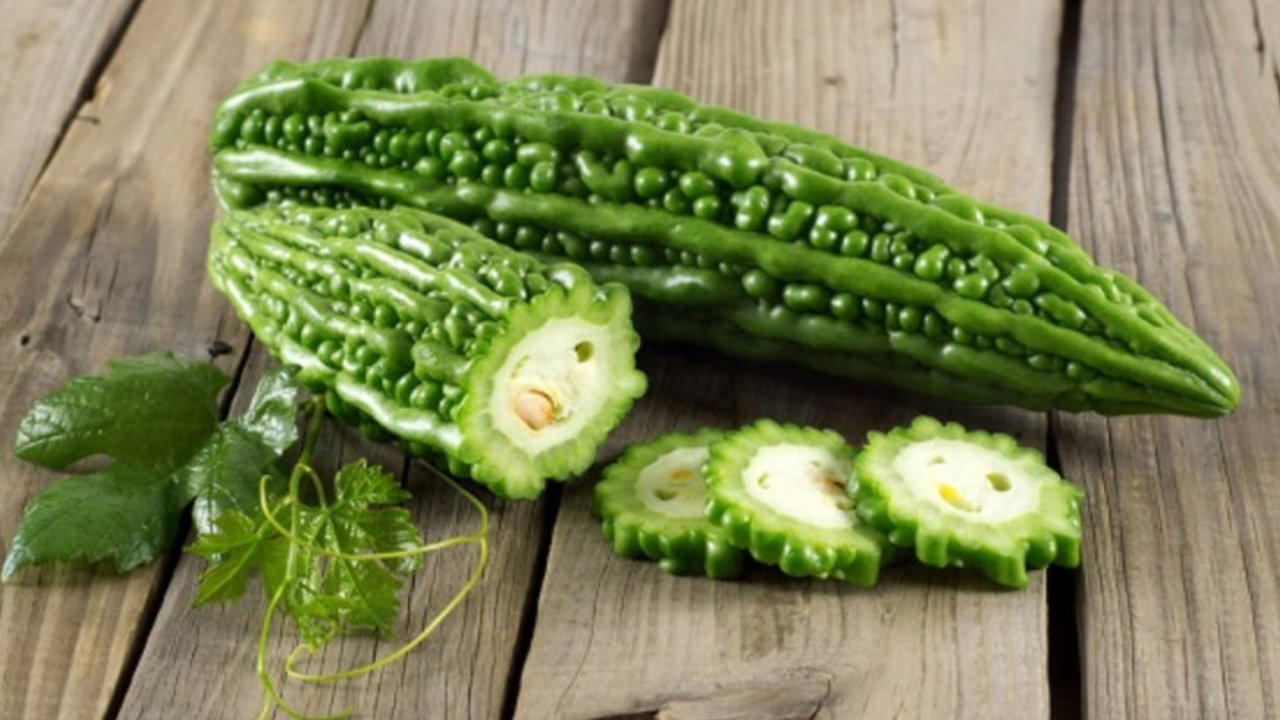Bitter Melon (Karela) Health Benefits & Side Effects
Bitter melon, known scientifically as Momordica charantia and commonly referred to as karela in many cultures, holds a prominent place in Ayurvedic medicine. Renowned for its distinct bitter taste, this tropical vine is celebrated not only for its culinary uses but also for its extensive medicinal properties.
In Ayurveda, bitter melon is recognized for its ability to balance the three doshas—Vata, Pitta, and Kapha. It is particularly effective in pacifying aggravated Kapha and Pitta doshas, making it beneficial for a variety of health conditions. The bitter taste, associated with detoxification and digestive health, plays a vital role in stimulating appetite and promoting healthy digestion.
Rich in essential nutrients, antioxidants, and phytochemicals, bitter melon is often utilized in Ayurvedic formulations to manage diabetes, improve digestive function, support liver health, and enhance immune response. Its anti-inflammatory and antimicrobial properties further underscore its significance in traditional healing practices.
Botanical Description of Bitter Melon (Bitter Gourd)
Botanical Name: Momordica charantia
Family: Cucurbitaceae
Growth Habit: Bitter melon is classified as an annual or perennial climbing vine. It can reach heights of 2 to 3 meters and may extend up to 5 meters in length, making it a vigorous climber suitable for trellises and supports.
Habitat: This plant can thrive at various altitudes, including high elevations, and is adaptable to different climates.
Stem: The stem of bitter melon is slender, green, and well-branched. It features unbranched tendrils that emerge from the leaf axils, aiding in its climbing ability.
Leaves: The leaves are simple and alternate, typically exhibiting 3 to 7 deeply separated lobes. When crushed, they emit an unpleasant smell, which can deter some herbivores.
Flowers: Bitter melon produces distinct yellow flowers, with separate male and female blooms. The flowering period occurs from June to July in the Northern Hemisphere.
Fruiting: Fruiting typically takes place from September to November. The fruits are oblong or cylindrical, measuring between 2 to 10 cm in length. They are characterized by a warty surface adorned with longitudinal ridges, contributing to their unique appearance.
Ayurvedic Properties of Bitter Melon
Bitter melon, known as Karela in Ayurveda, is valued for its extensive medicinal properties. Here’s a detailed overview:
Rasa (Taste):
- Tikta (Bitter): The predominant taste, associated with detoxification and digestive health.
- Katu (Pungent): Provides additional digestive benefits and enhances metabolic functions.
Guna (Qualities):
- Laghu (Light): Easily digestible and does not weigh down the body.
- Ruksha (Dry): Helps reduce excess moisture in the body, balancing Kapha dosha.
Virya (Potency):
- Ushna (Hot): Generates heat in the body, which can help stimulate digestion and metabolism.
Vipaka (Post-Digestive Taste):
- Katu (Pungent): After digestion, it promotes digestion and absorption of nutrients.
Effect on Doshas:
- Kapha Shamak: Helps pacify aggravated Kapha dosha, which can alleviate conditions like obesity and congestion.
- Pitta Shamak: Balances excess Pitta, useful in managing inflammatory conditions and skin disorders.
- Vata: Bitter melon does not increase Vata dosha, making it suitable for individuals with Vata imbalances.
Types of Bitter Gourd
1. Indian Bitter Gourd (Momordica charantia):
- Appearance: Bumpy, light green skin; larger size.
- Taste: Very bitter; widely used in Indian cuisine.
- Culinary Uses: Curries, stir-fries, and pickles.
2. Chinese Bitter Gourd (Momordica charantia var. abbreviata):
- Appearance: Smaller, smoother, and more elongated than the Indian variety.
- Taste: Slightly milder bitterness.
- Culinary Uses: Common in Chinese stir-fries and soups.
3. African Bitter Gourd (Momordica balsamina):
- Appearance: Rough, warty exterior; smaller size.
- Taste: Bitter flavor similar to Indian bitter gourd.
- Culinary Uses: Used in various African dishes and traditional remedies.
4. White Bitter Gourd (Momordica charantia var. muricata):
- Appearance: Creamy white, smooth skin.
- Taste: Less bitter, making it more versatile.
- Culinary Uses: Salads, light dishes, and soups.
5. Thai Bitter Gourd (Momordica cochinchinensis):
- Appearance: Dark green skin with prominent spikes.
- Taste: Very bitter; stronger than other varieties.
- Culinary Uses: Frequently used in Thai curries and stir-fries.
Traditional and medicinal uses of karela
Fruits
1. Diabetes Management: Karela fruits are celebrated for their hypoglycemic properties, making them effective in regulating blood sugar levels, particularly in diabetic patients. The consumption of bitter melon can improve insulin sensitivity and support overall metabolic health.
2. Digestive Health: The fiber-rich fruits aid in digestion, preventing constipation and promoting regular bowel movements. They also stimulate the production of digestive enzymes, enhancing nutrient absorption.
3. Respiratory Relief: Karela is traditionally used to alleviate respiratory issues, including asthma and cough. Its anti-inflammatory properties can help reduce bronchial irritation and improve breathing.
4. Skin Treatment: The fruit’s blood-purifying effects are beneficial for treating various skin conditions, such as boils, ulcers, and acne. Its antioxidants help combat free radicals, promoting healthier skin.
5. Nutritional Benefits: Karela fruits are rich in vitamins A and C, folate, and potassium, contributing to overall health and wellness. They can boost the immune system and promote skin health.
Leaves
1. Blood Purification: The leaves of karela are known for their detoxifying properties, helping cleanse the blood and reduce impurities. This can be especially beneficial for individuals with skin issues.
2. Menstrual Support: Karela leaves are used in traditional practices to address menstrual irregularities, promoting regular cycles and alleviating discomfort.
3. Fever Reduction: Traditionally, karela leaves have been employed to treat fevers, including those caused by malaria, due to their antiviral and antimicrobial properties.
4. Antiviral Properties: The leaves are also recognized for their potential in treating viral infections, including measles and hepatitis, due to their immune-boosting effects.
5. Digestive Aid: Karela leaves can help expel intestinal gas and relieve colic. They are often used in herbal teas for digestive health.
Seeds
1. Ulcer Treatment: The seeds of karela are effective in treating ulcers, promoting healing of the digestive tract, and reducing inflammation.
2. Liver and Spleen Health: Karela seeds support liver function and help address spleen-related issues, potentially aiding in the detoxification process.
3. Cholesterol Management: Research suggests that karela seeds may help lower cholesterol levels, contributing to cardiovascular health.
4. Antimicrobial: The seeds have been used to combat intestinal parasites and worms, making them valuable in traditional remedies for gastrointestinal health.
5. Nutritional Content: Karela seeds are a source of essential fatty acids and proteins, adding nutritional value to the diet.
Roots
1. Rheumatism and Syphilis Treatment: The roots of karela are traditionally used for conditions like rheumatism and syphilis, highlighting their role in pain relief and infection control.
2. Boils and Septic Swellings: Karela roots help treat skin infections and boils, promoting healing and reducing inflammation.
3. Menstrual Disorders: They may assist in treating conditions related to the reproductive system, including prolapsed uterus and menstrual irregularities.
4. Anti-inflammatory Properties: The roots possess anti-inflammatory effects that can help reduce swelling and pain in various conditions.
5. Traditional Applications: In some cultures, karela roots are used in poultices and infusions for topical and internal applications, showcasing their versatility in herbal medicine.
What Does Science Say?
Research indicates that bitter melon may help manage diabetes symptoms. A review published in April 2013 by the US National Library of Medicine highlighted the diverse health benefits attributed to various parts of the plant.
Specifically, bitter melon is beneficial for treating type 2 diabetes. Studies suggest that it contains compounds that can effectively control blood glucose levels and reduce blood lipid levels.
Overall, scientific findings support the consumption of bitter melon in several forms to help lower blood sugar levels in some individuals:
- Seeds: Contain beneficial compounds that may aid in blood sugar regulation.
- Mixed Vegetable Pulp: Offers a concentrated source of nutrients and bioactive compounds.
- Juice: A popular method for extracting the plant’s beneficial properties.
- Supplements: Convenient for those seeking to incorporate its health benefits into their routine.
These methods collectively highlight the potential of bitter melon as a valuable addition to diabetes management strategies.
Bitter Melon Medicinal Properties
Here are some key properties of bitter gourd that highlight its health benefits:
1. Nutrient-Rich: Bitter gourd is packed with essential vitamins, including vitamin C, vitamin A, and various B vitamins. It also contains important minerals such as potassium, calcium, and iron, making it a nutritious addition to any diet.
2. Antioxidants: This vegetable is rich in antioxidants, which help combat harmful free radicals in the body. These compounds support overall health and may reduce the risk of chronic diseases.
3. Blood Sugar Control: Bitter gourd is well-known for its hypoglycemic properties, making it effective in lowering blood sugar levels and improving insulin sensitivity. This is particularly beneficial for individuals managing diabetes.
4. Anti-inflammatory: The anti-inflammatory properties of bitter gourd can help reduce inflammation in the body, which is linked to various chronic conditions, including heart disease and arthritis.
5. Digestive Health: Rich in dietary fiber, bitter gourd promotes healthy digestion, prevents constipation, and supports gut health. It aids in regular bowel movements and helps maintain a healthy digestive tract.
6. Immune Boosting: The combination of vitamins and antioxidants in bitter gourd helps strengthen the immune system, enhancing the body’s ability to fight off infections and diseases.
7. Weight Management: Low in calories and high in fiber, bitter gourd can aid in weight management. It helps keep you feeling full longer, supports healthy metabolism, and is a great addition to weight-loss diets.


























bitter melon is it available in Norway or Europe in general, what Products is shop…?
Bitter melon is one of popular edible pod vegetable in many Asian countries. It is grown widely as a field crop as well as backyard vegetable and, in fact, is among the most bitter tasting of all culinary vegetables.